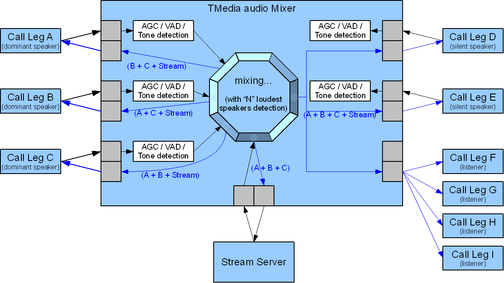AudioMixers
From TBwiki
Contents |
Toolpack audio mixers
A mixer is used to mix the audio of multiple sources (call legs, playing audio file, tone generation...)
Typical usage of audio mixers
Audio mixers can be used, among other things, to:
- Build conferences
- Play background music to a conversation
- Record both sides of the conversation into a single recorded file.
Joining audio source to a mixer
There are 2 ways to join a mixer:
- Join as a listener only
- Join as a talker. Talkers can be active / or inactive (inactive speakers are not mixed, but monitored for voice activity)
Maximum call legs per mixer
The mixer has the following capabilities:
- The mixer can have any number of listeners (up to maximum number of call legs supported by the TMedia system)
- The mixer can have any number of talkers (up to maximum number of call legs supported by the TMedia system)
- Among these talkers, up to 10 will be considered as "active" (the 10 from which voice was received the most recently)
- Among these 10 active talkers, the audio from loudest N talkers will be mixed (N can be configured per mixer)
Resource usage of mixers
- An active talker uses one mixer slot (up to 10 per conference)
- All non-active talkers use one mixer slot (although there is no per-conference limit)
- All listeners share one mixer slot
- IVR (playing file, playing tone, recording file) use one mixer slot
Note: Recording or playing files to individual call legs will not be done by the mixer itself, and will thus require separate DSP resources in addition to the mixer itself.
A Tmedia Unit has a density of about 512 mixer slots per DSP, and can have up to 4 DSPs.
